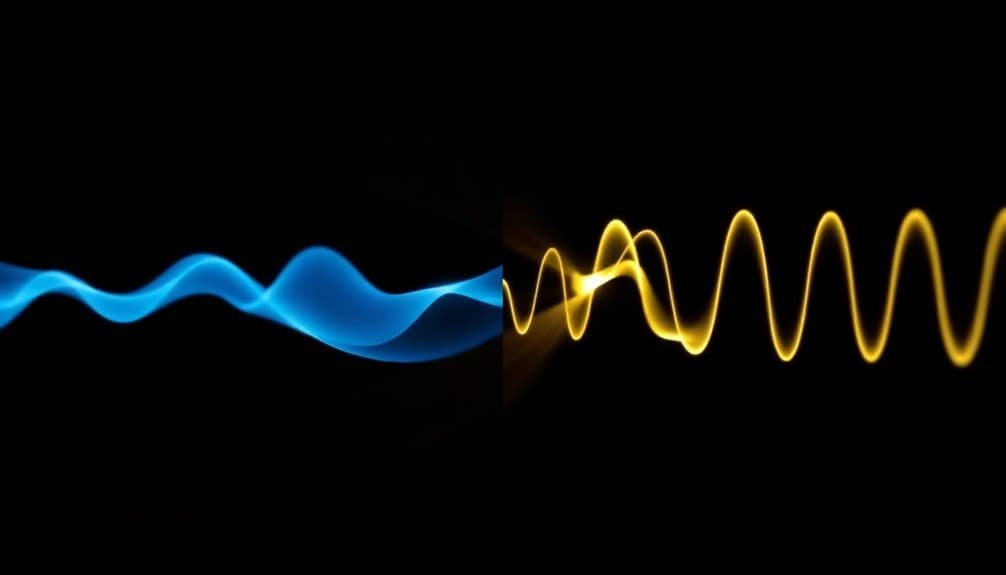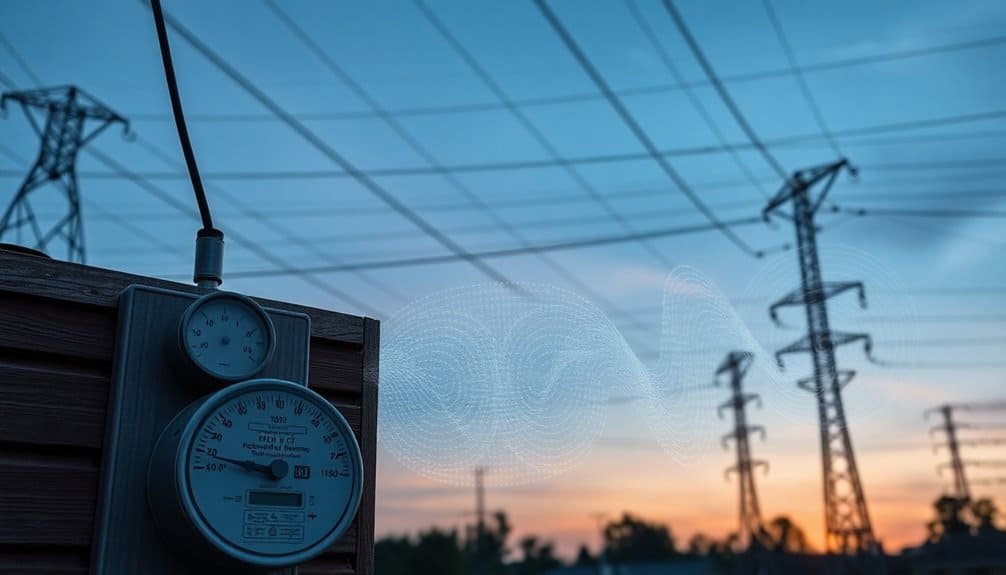Low-Frequency Vs High-Frequency EMF Effects
Low-frequency EMFs (0 to 300 Hz), emitted by power lines and household appliances, can induce electric currents in tissues, possibly linking to health issues such as childhood leukemia and depression. The biological effects of these EMFs need further exploration.
High-frequency EMFs (100 kHz to 300 GHz), from devices like cell phones and Wi-Fi routers, can alter cell membranes and potentially affect brain chemistry. Understanding their biological impact requires more research.
Disclaimer: As an affiliate, I may collect a share of sales from the links on this page.
Definition of Low-Frequency EMFs

Low-frequency electromagnetic fields (EMFs), often called extremely low frequency (ELF) fields, encompass a frequency range from 0 to 300 Hz.
These fields originate from various sources, including power lines, household appliances, and electrical distribution systems. Characterized by long wavelengths, an ELF field at 50 Hz measures 6,000 km. Importantly, these fields are non-ionizing, lacking the energy to break chemical bonds. ELF fields consist of both electric and magnetic components, which require separate measurements in practice.
Static fields can be classified as low-frequency fields, which helps clarify their impact and provides insight into ongoing public health discussions regarding exposure limits and potential risks.
Definition of High-Frequency EMFs
High-frequency electromagnetic fields (EMFs) range from 100 kHz to 300 GHz and include various components of the electromagnetic spectrum. These fields propagate as waves moving at the speed of light. They find widespread applications in wireless communication, such as mobile devices and data transmission. You can measure intensity through electric field strength, magnetic field strength, or power density. High-frequency EMFs encompass different bands, including HF, VHF, UHF, SHF, and EHF, each serving specific purposes, like broadcasting or satellite communications. Understanding these definitions helps you grasp the technology driving modern communication and its potential biological effects. Additionally, high-frequency fields enable the transmission of energy and information over long distances, enhancing connectivity in our daily lives.
Sources of Low-Frequency EMFs

Electromagnetic fields arise from various sources that greatly contribute to low-frequency electromagnetic fields (EMFs).
Power lines generate extremely low frequency (ELF) fields, which represent common exposure. Household appliances, like shavers, emit ELF EMFs during operation. Additionally, wiring and electrical infrastructure in homes greatly contribute to ELF exposure, as proper wiring is essential to minimize EMF levels. Facilities such as power plants and substations also produce ELF fields by generating and distributing electricity.
Industrial equipment, including induction heaters and welding machines, further adds to this exposure. Transformer boxes and high-voltage power lines increase exposure levels, emphasizing the importance of distance in managing ELF EMF effects. Furthermore, public exposure from high voltage power lines typically shows electric fields of 2-5 kV/m and magnetic fields less than 40 µT, illustrating the significance of these sources in everyday environments.
Sources of High-Frequency EMFs
Wireless communication devices, such as cell phones and tablets, are among the most significant sources of high-frequency EMFs. These devices operate within a frequency range of 100 kHz to 300 GHz and emit radiofrequency (RF) waves.
Additionally, broadcasting sources like radio and television transmission towers contribute to high-frequency exposure. Wireless networks, including Wi-Fi routers, also generate RF fields.
Medical equipment, such as MRI machines, and microwave ovens utilize high-frequency emissions for functionality. The charging process of these devices can emit a small amount of low-frequency RF energy, but it is negligible compared to the overall exposure from their operation.
Regulatory agencies, like the FCC, set exposure limits to mitigate potential risks. Monitoring guarantees public safety near these EMF sources while ongoing research examines their long-term effects.
Biological Effects of Low-Frequency EMFs

Understanding the biological effects of low-frequency EMFs is essential, as these fields can greatly influence various cellular processes.
Low-frequency electromagnetic fields (ELF-EMFs), typically involving frequencies up to 300 Hz, interact with biological tissues primarily through non-thermal mechanisms. They induce electric currents in tissues, modulating cellular signaling.
ELF-EMFs affect ion channel activity, DNA integrity, and hormone secretion, which can lead to changes in oxidative stress levels. While research suggests therapeutic applications—like neural modulation and enhanced wound recovery—more studies are needed to fully comprehend their mechanisms and long-term health implications, especially concerning fertility and immune system health.
Biological Effects of High-Frequency EMFs
High-frequency EMFs, ranging from 100 kHz to 300 GHz, penetrate biological tissues, leading to various cellular interactions.
These frequencies interact with polar molecules, such as water, causing changes in molecular alignment. Effects depend on field strength and exposure duration. You might notice reversible alterations in cell membranes at lower intensities, but high fields can induce irreversible changes.
Additionally, high-frequency EMFs can cause chain formation of cells, known as the “pearl-chain effect.”
In nervous tissue, RF radiation can affect brain chemistry and neuronal activity, potentially leading to symptoms like headaches and cognitive changes in sensitive individuals. Moreover, prolonged exposure to ionizing radiation can have severe health implications, highlighting the importance of understanding EMF effects.
Safety Regulations for Low-Frequency EMFs
As electromagnetic fields (EMFs) at low frequencies present unique biological interactions, safety regulations are essential in safeguarding workers and the public.
OSHA standards focus on exposure limits for workers near static and ELF fields, specifically from 1 Hz to 300 Hz. These guidelines include control measures to reduce adverse health effects and require training programs for those regularly exposed.
Safety Code 6 offers restrictions on induced currents to prevent nerve stimulation or burns, applying safety factors for varying physiological responses.
Compliance involves measuring electric and magnetic field strengths, ensuring that all exposure parameters remain within the established safety range.
Safety Regulations for High-Frequency EMFs
With increasing concerns over the health impacts of high-frequency electromagnetic fields (EMFs), regulatory agencies have established strict guidelines to protect everyone from potential risks.
The Federal Communications Commission (FCC) regulates human exposure, while OSHA adopts standards like ANSI C95.1-1982. The International Commission on Non-Ionizing Radiation Protection (ICNIRP) provides worldwide guidelines for safe exposure limits.
Standards include frequency-dependent limits, with reduced values for public safety. Compliance involves monitoring with calibrated instruments, measuring electric and magnetic field strength, power density, and induced currents.
Workplace safety programs employ engineering controls and PPE to mitigate risks, ensuring a safer environment for workers and the general public.
Health Risks Associated With Low-Frequency EMFS
Although evidence remains inconclusive, numerous studies indicate potential health risks linked to low-frequency electromagnetic fields (EMFs). Research suggests a possible connection between low-frequency EMFs and increased childhood leukemia risk.
You might also encounter studies associating low-frequency EMFs with depression and miscarriage. Proximity to power lines or faulty domestic wiring elevates exposure levels.
However, methodological limitations, such as selection bias and confounding factors, weaken the evidence. Inconsistent study results further complicate the understanding of health effects.
Biological effects, like oxidative stress and immune system impacts, remain areas of ongoing investigation as researchers aim for a clearer picture of these risks.
Health Risks Associated With High-Frequency EMFS
High-frequency electromagnetic fields (EMFs), which encompass radiofrequency fields similar to those used in mobile phones and Wi-Fi networks, have raised considerable health concerns.
These EMFs operate between 3 kHz and 300 GHz and mainly cause tissue heating due to energy absorption. Regulatory agencies impose exposure limits to prevent risks such as burns or thermal injuries.
While some studies examine possible links to cancer, neurological effects, and cardiovascular risks, conclusive evidence remains elusive.
Current guidelines from organizations like the WHO and ICNIRP recommend safe exposure levels, emphasizing the importance of ongoing research into high-frequency EMF effects on health.
Frequently Asked Questions
How Can I Measure My Exposure to EMFS at Home?
To measure your EMF exposure at home, use certified EMF meters. Scan rooms, focusing on areas near appliances and wiring. Regularly check levels, maintain records, and consider professional assessments for thorough understanding and safety.
Are There Any Protective Devices Against EMF Exposure?
Yes, there are protective devices against EMF exposure, including shielding fabrics and specialized gadgets. However, be cautious, as many products lack scientific backing and might not effectively reduce your exposure. Always research before purchasing.
What Are Common Misconceptions About EMF Health Risks?
You might believe that EMF exposure directly causes serious health risks, but misconceptions abound. Studies show limited evidence, while media often sensationalizes claims, overshadowing reassurances from scientific consensus regarding typical EMF safety levels.
How Do EMFS Impact Fertility and Reproduction?
You might believe EMFs harmless, yet they can disrupt fertility and reproduction. While some studies suggest changes in sperm and egg quality, others indicate minimal impact. Understanding this nuance is essential for informed choices regarding exposure.
Can EMF Exposure Affect Mental Health or Mood?
Yes, EMF exposure can affect your mental health and mood. Studies suggest it may disrupt neurotransmitter balance, leading to increased anxiety, depression, and cognitive impairments, particularly with prolonged exposure or high-intensity electromagnetic fields.
Conclusion
Understanding low-frequency and high-frequency EMFs is crucial. Low-frequency EMFs come from power lines and appliances, while high-frequency EMFs stem from wireless devices and transmitters. Both types pose potential health risks and require adherence to safety regulations. Imagine a balance scale, with technology’s benefits on one side and its risks on the other. Staying informed helps you navigate this electromagnetic landscape safely, ensuring personal well-being alongside technological progress.






